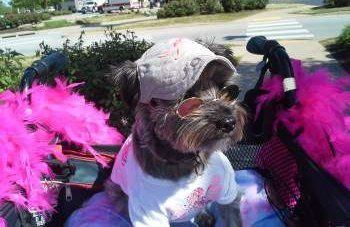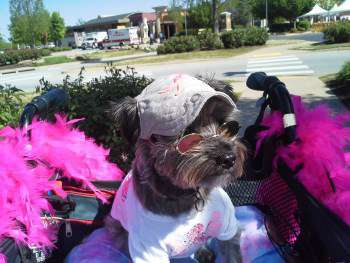Yorkshire Terrier is Afraid of Cars, Traffic
Overview
One of the most common reasons for owners being reluctant to take their dogs for walks in the neighborhood is their dog's fear of traffic.
It's not uncommon for dogs to be afraid of cars and traffic and this is particularly common with toy breed dogs such as the Yorkshire Terrier.
After all, can you blame our dogs?
From their perspective, there are valid things to be afraid of.
Automobiles, pick-ups and other vehicles that are massively larger than our Yorkies go whizzing by at fast rates and sometimes awfully close as well even if you are on a sidewalk.
In fact, with the average car weighing 3500 pounds and going approximately 35 mph in a 'thickly settled district', these barreling metal vehicles are about 500 times the weight of a typical adult Yorkie and going at speeds that seem awfully fast to a toy sized dog.
Even if you walk with your Yorkshire Terrier near the grassy side, with the typical width of a sidewalk being 42 inches, a dog is only 4 to 5 feet away from cars traveling
on that side of the road.
This section will discuss how to help your Yorkie learn to not be afraid of cars and traffic. It can take some time to train for this, however most dogs learn relatively quickly if owners do consistent training. We will also do a reader Q&A regarding other traffic related issues such as barking at cars while on a walk, in the house or while being driven.
Please note:
YorkieInfoCenter is reader-supported, and some of the product suggestions on this page are affiliate links. As an Amazon Associate we earn from qualifying purchases. This is at no extra cost to you and helps us continue providing free, high-quality information.
Signs of Being Afraid of Traffic
Most dogs that are scared of cars passing by will behave in the same way. The most common signs are:
- Pulling on the leash to move away in the opposite direction of where the cars are
- Walking too close to you or trying to keep himself right behind you
- Whining and shaking
- The ears
are held back
- Jumping (sometimes with snapping)
- Lying down and refusing to walk
Training for Traffic Phobia
While we know that our Yorkie will be safe while walking on the sidewalk with us, our dog has no idea. Traffic can be exceedingly overwhelming to a dog that is afraid of it, however gradual training that includes exposure can help many dogs overcome this fear.
As with many elements that we must socialize our dogs to, the best method of helping a Yorkie that is afraid of traffic is a slow introduction to it. Even if you have already been out on the busiest of roads, it will be time to go back to the very beginning to start off with a fresh, clean slate.
Preparing
- Due to his size, it is always recommended to use a harness
when you have a Yorkshire Terrier on leash, however particularly for situations such as this when a dog is scared and may be jumping or pulling, a harness is the way to go. It offers you better control while eliminating the chance of neck injury (collapsed trachea) that can occur when tension and force are placed on a dog's neck.
There are several types of harness that are good for toy breeds including mesh, vests and straps. Vests are easy clothing pieces that slip on (or are zippered up), with a leash attachment on the back. Strap harnesses work well also, and are easy to get on and off if it has a 'quick release' located on the stomach area.
You'll want to use a short 6 foot leash or a retractable leash when walking near traffic so that you can keep your Yorkie the appropriate distance from you and of course, to make sure that he does not run into the street (some dogs that are afraid of traffic will bark at and even try to chase cars).
Beau, 1 year old
Photo courtesy of Karla Stewart
Step 1-
To even prepare your Yorkie to handle walking near busy roads with lots of cars, it is always best to first practice heeling.
If your dog is always walking ahead of you, is able to cower behind you or even tried to circle you when afraid, it is much harder to do any sort of training.
For this reason, it is recommended to first go to an area without any traffic. While a large yard will work, we usually suggest a track at a school or a non-dog park where you can walk a route and really get in some good practice.
Your goal will be to have your Yorkie to your left and walking in tandem with you, at the pace that you set. Do keep in mind that the speed should be comfortable and slightly brisk for your Yorkie.
If a dog has to struggle to keep up with an owner, he will have a hard time learning the rules.
Opposite to that, if you go too slowly, it allows a dog to get distracted from the task at hand.
Step 2- Once your Yorkie has a good sense of how to heel to you, it will be time to expose him to just a bit of traffic; which is known as desensitization training.
It will not be enough to elicit overwhelming fear; however will be a good opportunity to learn that cars driving by are not so scary after all. This is done by choosing a quiet neighborhood where you can estimate that with a 20 minute walk, 2 to 3 cars may pass by.
You may need to drive to various neighborhoods to find one with this amount of light traffic, so bring water, along with treats which will be needed for the training.
The goal is to walk your Yorkie, with him being on your left (even if that needs to be on the traffic side of the sidewalk) and 100% completely ignore any attempts to run, go behind you, jump, bark or other behavior. With the leash kept exactly at the length required for your dog to be right by your side, with the harness on and walking at the correct pace, you will be able to forge ahead despite any actions your Yorkie tries to take and will be able to do this without harming him.
Be careful to not tense up when you see or hear a car coming.
Dogs are remarkable at being able to read and sense an owner's feelings. If you feel nervous in anticipation of how your Yorkshire Terrier is going to react to traffic, this in and of itself can make a dog nervous. As the car is coming closer, reaffirm proper walking by matter-of-factly saying "Heel, good heel" several times in a confident voice.
Do not look over at your Yorkie when the car passes. Simply walk, holding the leash tightly as if nothing at all happened. Once the car if out of sight, if your Yorkie did okay you can pause and offer a small treat (have these ready in your pocket for easy dispensing). If he did indeed jump or try to run, don't offer a treat, however do speak in a casual voice and keep going.
After 20 minutes, it will be time to end the session and whether or not your Yorkie was afraid or did indeed handle himself well, give praise and a treat for a job well done (or for at least trying). It is important to show enthusiasm both before and after a walk; dogs often tend to eventually believe that something is fun if the owner acts as if it is.
Note:
If a dog is still so scared of even just one car passing by, you can try another method in which you have exceptional treats ready (something like real bacon, cooked crisp and broken up into pieces). When you know that a car is going to pass by, stop walking, kneel down and be looking right at your Yorkie. Wave the piece of bacon to gain his undivided attention, toss it toward the grass and give the 'Find' command.
If your Yorkie is finds the treat and gobbles it up without paying attention to the car, this shows that he is able to remove his focus from the threat and fear of the car.
This is a good sign that desensitization will work.
Over time, you can progress to simply getting his attention when traffic comes down the street. The next step from that is to simply be able to say his/her name. Only once he is successful with this, will it be time to move things up a notch.
Step 3- It may take 2 days to get to this point or it may take 2 months; however do not move up to this next phase until your Yorkshire Terrier has proven that he has learned to handle walking with light traffic without any issues. When a dog is exposed to something enough times… and each of those times the owners is showing by example, actions and words that nothing is scary, a dog will ultimately learn the lesson.
This next step in teaching a Yorkie to not be afraid of cars is to go to an area with moderate traffic. Choose a spot that you estimate will have 10 or so cars passing by within a 20 minute time frame.
You will repeat the same actions as you did for Step 1.
Reader Q&A Regarding Cars and Traffic
Can a Yorkie learn to walk near lots of fast traffic without being scared?
Each dog has his limits as to what he can handle. Since it is rather logical that dogs fear cars, we can't expect a Yorkie to happily walk alongside heavy, fast traffic in a calm manner.
How do I handle barking at cars?
Many dogs bark at cars because the car appears to be entering the dog's space and he/she sees it as a threat. As with getting over fear of traffic, only practice taken in gradual steps can help with this. When your Yorkie barks, you will keep walking as if nothing is happening. As long as you have a proper leash on your dog, he will not be harmed if you continue to walk at the correct pace.
Treats are only to be given out if a car passes by and he does not bark. Many dogs that bark at cars will have a least one incident of being quiet when a car goes by… even if it is just from pure exhaustion from barking… . it is at this time that a super good treat and encouraging praise should be given.
Dogs learn very fast to repeat a behavior if it brings about good results. So when barking at cars = nothing at all and not barking = a tasty treat and his owner's attention, most dogs will learn to choose the latter.
My Yorkie barks at cars from inside the house
- This can be tricky for those who live on busy roads. Cars can be a near constant trigger for barking and other signs of disturbance behavior. If your Yorkie's normal resting area is right by an outside wall that is close to the street, you may want to think about moving his spot. In some cases, distraction and treat training can work.
This is done by shaking a can with pennies or by clapping loudly as soon as the dog barks. The moment you have his attention, you will give the "Quiet" command, and say this as if you are wondering if he will indeed listen, as in "Quiiiii-etttt…."
If he stays quiet for a count of 3, give him a small treat and praise. After several weeks, many dogs will be happy to just receive the praise and treats will not need to be given.
My Yorkie barks at cars when he's in the car with me
- Being driven around is not easy on some dogs; being in a car can put a dog on high alert. If you combine this with a Yorkie that also does not like the motion of the car, you can have a frustrated dog that barks at all the cars around him.
In time, most dogs do become accustomed to being in the car. If your Yorkie shows any signs of being carsick, this should be addressed first by timing meals and making sure that he has access to fresh air from the window.
If you'll be going on a long car trip, you may want to speak with the vet about medicine to control motion sickness.
Desensitization training can work well for these cases also; done by a slow exposure to a lightly traveled road and then building up once the dog learns to calm down.
The most important element here is to make sure that your Yorkshire Terrier is secure in a quality canine car seat
so that no matter how frustrated he may become at other cars, he will remain safe.
Joey, 2 years, 10 months
(at the Susan Komen Bark for the Cure 2015)
Photo courtesy of Carol Hunter
Obtaining some new toys and offering one before each drive may help in regard to distraction.
My Yorkie is scared of traffic noise, not only of the actual cars - There are cases where a dog will do just fine walking down the street but will be afraid of traffic noise that may be coming from an adjacent road. This is actually common with puppies
that really just need to get used to the world and all of the noises in it.
As with the other training discussed above, gradual desensitization is really best. You'll want to go for walks on quiet roads and slowly work your way up to those that are more open to passing sounds of trucks and other vehicles.
Why does my Yorkie try to chase after cars?
While some dogs give chase because they perceive cars to be a threat, with other dogs, it evokes the urge to 'give chase' for the thrill of the 'hunt'. Any fast moving object may 'tease' a dog, causing him to want to run after it. While the Yorkshire Terrier was originally bred to be a 'ratter', chasing after small rodents, some will want to chase after larger 'prey' including cars.
The best way to handle this is to 1)
practice heeling and 2)
use the distraction technique described above for if a dog is exceedingly terrified of traffic.
You will have very special treats ready to go in your pocket and gain his attention before the car is beside you. Get his attention, tempt him with the aroma of the reward and toss it to the side (away from the car). Over time, he will learn that paying attention to you is much more fun and offers more benefits than trying in vain to chase a car (since he won't go very far when you have him properly on harness and leash).
Things to Do Now:
Become a Member
(if you are not already a Member) - Receive reminders when we add new pages of info to this site. You will also receive a free & helpful Welcome eBooklet.
Browse Yorkshire Terrier Supplies, for all of our top recommended items to ensure optimal care.
Check out our book
- Simply the most comprehensive, helpful Yorkshire Terrier book that exists - in both Print & eBook.
Popular Page
Yorkshire Terrier size
- Comparison to other breeds & Yorkies that are smaller or larger than the standard.





